Growing cotton requires the utmost care, as it is cultivated for its lint, and even a small oversight can directly affect the grade of the fibre as well as the colour of the lint. During their growth cycle, cotton plants face several adversities, including fungal infections, nutrient deficiencies, physiological disorders and pest incidence. Along with these problems, cotton crops are majorly infected by bacteria that can cause bacterial blight. This disease can be hazardous to the crops, as it is known to cause yield losses of 30-35%.
Bacterial blight in cotton is caused by the bacterium Xanthomonas campestris pv. malvacearum. This bacterium attacks the crop at all stages, from seed to harvest, and the disease is known to show symptoms in five phases.
5 Signs of Bacterial Blight in Cotton
- Seedling Blight
- Angular Leaf Spot
- Vein Necrosis / Vein Banding
- Black Arm
- Boll Rot
Symptoms of Bacterial Blight in Cotton
Seedling Blight

On seedlings, bacterial blight initially appears as small, water-soaked spots on the cotyledons.

In later stages, these symptoms spread to the stem through the petioles, eventually causing withering and death of the seedlings.
Angular Leaf Spot
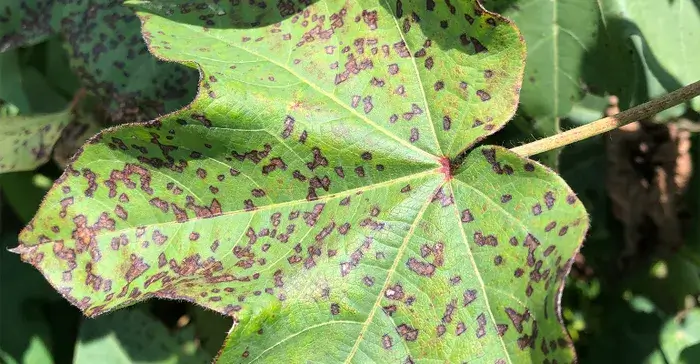
Angular leaf spot is one of the symptoms of bacterial blight in cotton.
On the lower surface of the leaves, you can observe small, water-soaked lesions which, in the later stages, turn into angular spots (either triangular or rectangular) as these spots are restricted by veins and veinlets and will appear on both sides.

When these spots appear on the upper side of the leaves, they will be seen encircled by a yellow halo.
The spots will turn red and spread from the leaves to the veins or veinlets if not treated properly.
Vein Necrosis / Vein Banding
When the symptoms spread from leaves to the veins and veinlets, the veins appear as black streaks, giving them a lightning bolt-like appearance.
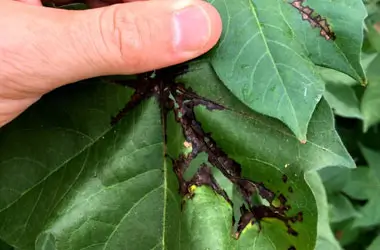
It might become difficult to differentiate lesions caused by bacterial blight from those caused by other organisms; lesions caused by bacterial blight will be darker compared to other symptoms.
On the underside of the leaves, you can observe crust formation due to the presence of bacterial oozes.
The affected leaves show crinkled symptoms and are twisted inward.
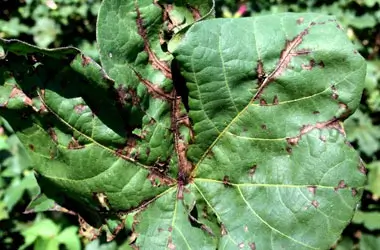
The infection later spreads from veins to petioles and shows a blighting appearance, even affecting the petioles and leading to defoliation
Black Arm of Cotton
When the symptoms spread from the veins to the petioles, dark brown to black lesions occur on the petioles.

These symptoms cause girdling of the stem and branches, resulting in the drooping of leaves.
Bacterial blight symptoms on the stem cause cracking, and the affected parts typically hang as dry black twigs, giving rise to the characteristic ‘black arm’ symptom
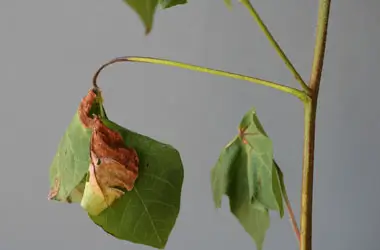
Boll Rot
The disease spreads from petioles to bolls, causing water-soaked lesions on bolls that turn into dark black sunken irregular spots.

If not taken care of, the disease spreads to the whole boll, causing shedding. Bursting of bolls is a symptom of bacterial blight.
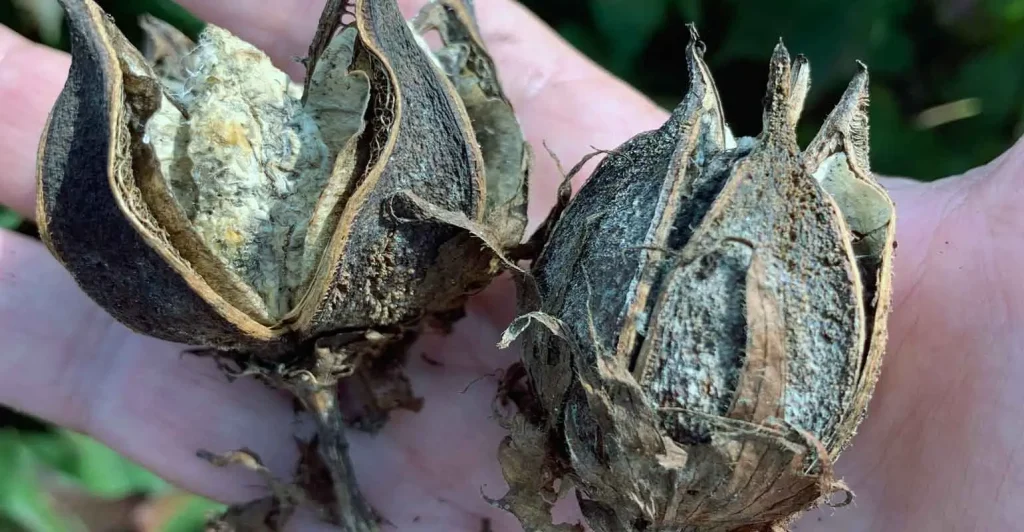
The bacterium spreads inside the boll, and lint gets stained yellow due to bacterial ooze, losing its appearance and market value.
The pathogen also infects the seed, causing a reduction in size and viability.
What causes the disease to occur? How does it spread to healthy cotton plants?
Mode of Spread of Bacterial Blight in Cotton
- The bacterium can live on infected, dried plant debris in the soil for several years.
- It is also carried by seeds, remaining as a slimy mass on the seed coat fuzz.
- The primary way the infection starts is through these infected seeds.
- Once the disease occurs, the bacterium spreads through wind, rain splash, irrigation water, insects and farming tools.
- This makes it easy for the disease to spread widely and quickly under the right conditions.
Bacterial Blight in Cotton: Disease Cycle
The bacterial blight causing bacteria can survive in infected, dried plant debris in soil for several years.
It is also carried on seeds, remaining as a slimy mass on the seed coat fuzz.
In addition to its primary plant host, it can infect other plants such as Thunbergia thespesioides, Eriodendron anfructuosum, and Jatropha curcas.
The initial infection typically arises from bacteria present on the seeds. Secondary spread of the bacteria occurs through wind, rain splash, irrigation water, insects, and contaminated equipment.
Favourable Conditions for Bacterial Blight in Cotton
Bacterial Blight in cotton survives under specific conditions that acts as a favourable condition to promote the spread and severity of the disease.
Soil and Temperature:
The incidence is high if the optimum soil temperature is around 28˚C
High temperatures ranging from 30-40˚C plays a major role in disease development
Humidity and Weather:
Relative Humidity: 85% is ideal for the disease to develop.
Rain followed by bright sunshine during October and November significantly increases the risk.
Agricultural Practices:
Care during each and every step of agriculture practices in the field is important
Early planting can contribute to disease development.
Delayed Thinning: Not thinning plants timely can worsen the condition.
Poor Tillage: Inefficient soil preparation can develop disease as infected plant debris should be removed and destroyed.
Late Irrigation: Delaying watering can stress plants, making them more susceptible.
Potassium Deficiency: Low potassium levels in the soil can weaken plant resistance.
Disease Entry and Spread:
The bacterium can enter plants through natural openings like stomates, lenticels, and hydathodes or through wounds caused by wind-blown sand.
Rainfall after Planting: Rain shortly after planting can lead to a rapid increase and spread of the bacteria.
Canopy Development: Once the plant canopy develops, heavy rainfall followed by warm, humid conditions with relative humidity over 85% further promotes the disease.
Even a single seed infected with Xanthomonas campestris pv. malvacearum (the bacterium causing Bacterial Blight) out of 6,000 can start an epidemic under favourable conditions.
By monitoring and scheduling the practices accordingly, farmers can prevent the entry of disease in the field and control the disease in the field effectively
Controlling Bacterial Blight in Cotton: Preventive Measures and Management Practices
Preventive Measures:
Seed Treatment
Delinting with Sulphuric Acid: Use concentrated sulphuric acid at 100 ml/kg of seed to delint the cotton seeds.
Chemical Treatment
Treat the delinted seeds with either Carboxin or Oxycarboxin at 2 g/kg of seed or soak the seeds in a 1000 ppm solution of Streptomycin Sulphate overnight before sowing.
Management Practices:
Cultural Practices
Sanitation is important. Remove and destroy infected plant debris to prevent the spread of the disease. Rogue out the volunteer cotton plants and weed hosts that may harbour the pathogen.
Follow a crop rotation with non-host crops to break the disease cycle.
Practice early thinning to reduce plant density and improve air circulation and early earthing up with potash to promote healthy plant growth.
Grow resistant cotton varieties such as Sujatha, 1412, and CRH 71 to reduce susceptibility to bacterial blight.
Chemical Control
Prepare a mixture of Streptomycin Sulphate and Tetracycline at 100 g along with Copper Oxychloride at 1.25 kg/ha.
Spray this mixture on the cotton plants to control the bacterial blight.
Knowing how bacterial blight spreads helps farmers prevent it. Use treatments on seeds, follow good farming practices, and use chemicals when needed. Being watchful and acting early helps protect cotton crops, ensuring a better harvest. Always consult an expert before going for chemical control.